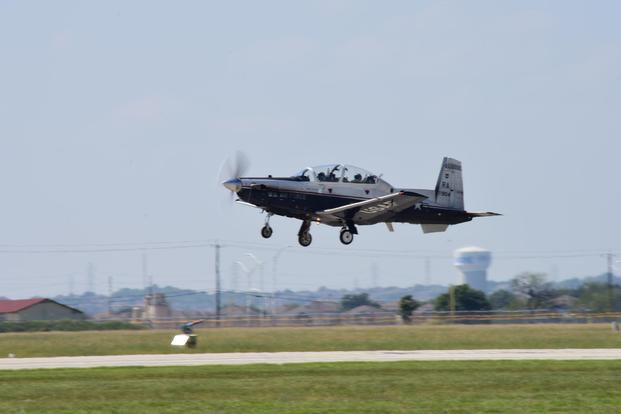A T-6 Texan trainer from Joint Base San Antonio-Randolph crashed roughly 30 miles from the base near Rolling Oaks Mall, Air Education and Training Command officials said Tuesday.
"The crew ejected and is safe with minor injuries reported at the site," AETC said in a Facebook post. "There were no civilian casualties, and the extent of damage to property has not been assessed," officials said.
Members from the base's fire and safety units from the 12th Flying Training Wing responded to the incident alongside and local responders, the announcement said.
Two parachutes were seen deploying from the aircraft, indicating the airmen ejected prior to the crash, Col. Dedra Witham, AETC spokeswoman, told reporters during the Air Force Association Air, Space and Cyber conference.
The Air Force is investigating the incident, Witham said.
The crash follows that of another trainer in Texas just last week. A T-38C Talon from Sheppard Air Force Base, Texas, crashed right after takeoff Sept. 11, officials said.
Two pilots from 80th Flying Training Wing ejected safely in that incident and were taken for evaluation, officials from Sheppard said in a statement. Both pilots were deemed stable. The crash remains under investigation.
Including the two recent trainer crashes, the Air Force has lost nine aircraft in non-combat training accidents this year, including an HH-60 Pave Hawk helicopter, two other T-38 Talon trainers, a WC-130 Hurricane Hunter, two F-16 Fighting Falcons -- one from the Thunderbirds demonstration team -- and a Kadena-based F-15 Eagle.
Related content:
- Retired Air Force Four-Star: How to Solve Aviation Crisis
- Air Force Wants to Predict Aviation Accidents Before They Happen
- Total Hydraulic Failure Caused Deadly T-38 Crash in November, Air Force Says
Additionally, an A-29 Super Tucano crashed at Holloman Air Force Base, New Mexico, in June as part of the Air Force's Light Attack Experiment.
Several of the accidents involved fatalities.
Others incidents include flightline mishaps, paused operations at bases, emergency landings and even stand-downs of entire fleets.
For example, Air Force Global Strike Command grounded the entire B-1B Lancer fleet for nearly two weeks in June over safety concerns related to the aircraft's ejection seats. More recently, an F-35A Joint Strike Fighter at Eglin Air Force Base, Florida, suffered a ground mishap that caused its nose gear to collapse following an in-flight emergency.
-- Oriana Pawlyk can be reached at oriana.pawlyk@military.com. Follow her on Twitter at @Oriana0214.













